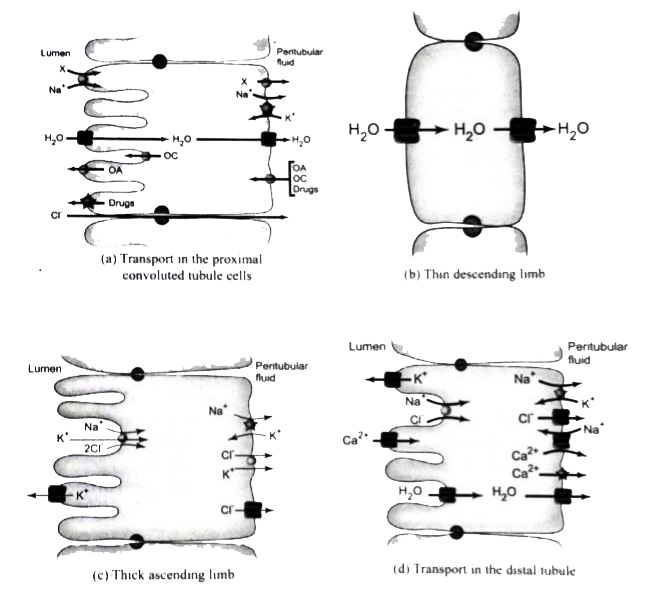What are the three stages of urine formation ?Solution in Tamil
The nitrogenous waste formed as a result of breakdown of amino acids is converted to urea in the liver by the Ornithine cycle or urea cycle. Urine formation involves three main processes:
1. Glomerular filtration
2. Tubular reabsorption
3. Tubular secretion.
1. Glomerular Filtration: Blood enters the kidney from the renal artery, into the glomerulus. The glomerular membrane has a large surface area and is more permeable to water and small molecules present in the blood plasma. Blood enters the glomerulus faster with greater force through the afferent arteriole and leaves the glomerulus through the efferent arterioles, much slower. This is because of the wider afferent arteriole and glomerular hydrostatic pressure which is around 55 mm Hg. This is the chief force that pushes water and solutes out of the blood and across the filtration membrane. The pressure is much higher than in other capillary beds. The colloidal osmotic pressure (30 mm Hg) and the capsular hydrostatic pressure (15 mm Hg) are the opposing forces. The net filtration pressure of 10 mm Hg is responsible for the renal filtration.
Net filtration pressure = Glomerular hydrostatic pressure - (Colloidal osmotic pressure + Capsular hydrostatic pressure) = 55 mm Hg –(30 mm Hg + 15 mm Hg) = 10 mm Hg. The effective glomerular pressure of 10 mm Hg results in ultrafiltration. The fluid that leaves the glomerular capillaries and enters the Bowman's capsule is called the glomerular filtrate. It is similar to blood plasma except that there are no plasma proteins. Kidneys produce about 180L of glomerular filtrate in 24 hours. It has water, glucose, amino acids and minerals along with urea and other nitrogenous waste.
2. Tubular Reabsorption: The substances of glomerular filtrate are reabsorbed by the renal tubules as they are needed by the body. This process is called selective reabsorption. In the Proximal Convoluted Tubule, glucose, lactate, amino acids, Nat and water are reabsorbed. Sodium is reabsorbed by active transport through sodium-potassium pump. The descending limb of Henle's loop is permeable to water due to the presence of aquaporins, but impermeable to salts. Water is lost in this region and hence gets concentrated in the filtrate. In the ascending limb of Henle's loop, are reabsorbed. This region is impermeable to water.The distal convoluted tubule reabsorbs water and secretes potassium into the tubule. and water remains in the filtrate. In the collecting duct, water and are reabsorbed and is secreted.
3. Tubular secretion: In this process, substances such as , creatinine and organic acids move into the filtrate from the peritubular capillaries into the tubular fluid.
human produces 1.5 L of urine per day.

Topper's Solved these Questions
- BOOK - FULL MARKSCHAPTER - EXCRETIONEXERCISE - ADDITIONAL QUESTIONS SOLVED ( FILL IN THE BLANKS ):45videos
EXCRETION
- BOOK - FULL MARKSCHAPTER - EXAMINATION QUESTION PAPER - MARCH 2019EXERCISE - Bio - Zoology (PART - IV)4videos
EXAMINATION QUESTION PAPER - MARCH 2019
- BOOK - FULL MARKSCHAPTER - KINGDOM ANIMALIAEXERCISE - ADDITIONAL QUESTIONS SOLVED (ANSWER THE FOLLOWING QUESTIONS)86videos
KINGDOM ANIMALIA
Similar Questions
............ regulation is the control of tissues osmotic pressure which acts as a driving force for movement of water across biological membranes.
03:25View SolutionWrite the kingdom, phylum and class for Pigeon. Write the characteristics of birds that are suitable for flying.
01:10View SolutionDistinguish invertebrates and chordates.
02:21View SolutionWhat are the main processes of urine formation ?
01:37View Solution___,_____ and ____ are three processes involved in urine formation.
02:04View SolutionWhat are the main processes of urine formation ?
01:30View Solutionमूत्र निर्माण के तीन चरणों के नाम लिखे।
05:03View SolutionWhat are the materials present in urine?
01:27View SolutionHow many stages are involved in the formation of urine ?
01:37View SolutionWhat are the different stages in the formation of urine? Explain what happens in those stages
05:04View Solutionమూత్రం ఏర్పడే విధానం లో దశలు ఏవి?
01:54View SolutionWhat are the three stages of urine formation ?
05:38View SolutionWhat is hemodialysis Explain the mechanism of urine formation in humans.
06:12View SolutionWhat are the main processes of urine formation ?
45:56View SolutionState about the three stage process of urine formation.
03:39View Solution

